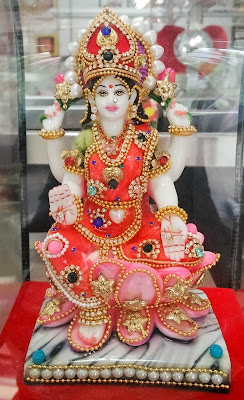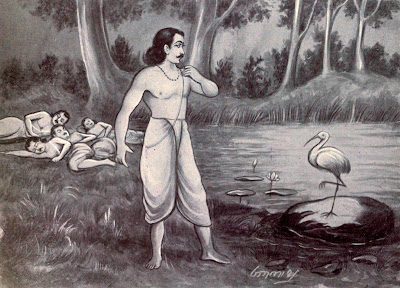Reading Notes: Ramayana Part C
Some of the Important Characters
-Sugreeva: King of Kiskinda, restored to the throne by Rama
-Vali: Brother to Sugreeva, defeated by Rama
-Tara: Sugreeva's wife, stolen by Vali but ultimately restored to him
-Angada: Sugreeva's son
-Hanuman: Monkey God, bestowed with the task of serving Rama
-Ravana: Demon lord, kidnaps Sita, engages in a war against Rama
-Vibishana: Asura who defects to help Rama in the fight against Ravana and his armies
Story Idea: The Villains Fight Back
There is a common theme among all the battles in the Ramayana: Rama ultimately defeats the enemy he is facing, restores justices, and prevails as the hero. Despite the fact that the evildoers he faces have committed wrongdoing in the world, they all have unique backgrounds and are exciting characters in the story. I believe their stories deserve to be told! And a fun way to do this would be to have all of them team up to take on Rama, with an epic battle ensuing. Perhaps in the end they will all lay slain, as in the original, or alternatively, they may realize the error of their ways and join the army of Rama's devoted followers. Will one hero prevail, or will a team of the most powerful villains ultimately overwhelm Rama and seize control over the world?
The Eagles (cue "Life in the Fast Lane")
There are several important characters in the Ramayana who assume the form of eagles; they appear to symbolize strength, wisdom, and justice. The story of Jatayu and Sampati is particularly intriguing, and I would like to delve further into their history. The moral I took away from the story of Sampati's burned wings was the idea of how our gifts (in the case of the eagle, the ability to fly) can be our downfall (quite literally in Sampati's case). I was also left with questions: why did Jatayu never seek his brother out? Was he perhaps ashamed that his brother had protected him and ultimately been the one to suffer? Were they reunited in the heavens and once more able to fly side by side?
The Conduct of Warfare
Morality is very important to the characters of the Ramayana, even those who have evil tendencies (the exception being Ravana's kidnapping of Sita). Enemies are expected to face one another in a way that is fair and respects the rules of war. Deceit and trickery are looked down upon as dishonorable, and taint the reputation of those who engage in such actions. Examples:
-Hanuman is spared because Ravana is reminded that he is a messenger, and messengers should not be killed.
-Ravana is left to recover after fainting before Rama resumes his attacks, even though he could easily have killed the demon as he lay motionless.
-An enemy should always be looked in the eye as they are struck the death blow; scars left on the backside are the mark of a devious and disgraceful attacker.
~~~
Bibliography
Narayan, R.K. The Ramayana: A Shortened Modern Prose Version of the Indian Epic.
-Sugreeva: King of Kiskinda, restored to the throne by Rama
-Vali: Brother to Sugreeva, defeated by Rama
-Tara: Sugreeva's wife, stolen by Vali but ultimately restored to him
-Angada: Sugreeva's son
-Hanuman: Monkey God, bestowed with the task of serving Rama
-Ravana: Demon lord, kidnaps Sita, engages in a war against Rama
-Vibishana: Asura who defects to help Rama in the fight against Ravana and his armies
Story Idea: The Villains Fight Back
There is a common theme among all the battles in the Ramayana: Rama ultimately defeats the enemy he is facing, restores justices, and prevails as the hero. Despite the fact that the evildoers he faces have committed wrongdoing in the world, they all have unique backgrounds and are exciting characters in the story. I believe their stories deserve to be told! And a fun way to do this would be to have all of them team up to take on Rama, with an epic battle ensuing. Perhaps in the end they will all lay slain, as in the original, or alternatively, they may realize the error of their ways and join the army of Rama's devoted followers. Will one hero prevail, or will a team of the most powerful villains ultimately overwhelm Rama and seize control over the world?
The Eagles (cue "Life in the Fast Lane")
There are several important characters in the Ramayana who assume the form of eagles; they appear to symbolize strength, wisdom, and justice. The story of Jatayu and Sampati is particularly intriguing, and I would like to delve further into their history. The moral I took away from the story of Sampati's burned wings was the idea of how our gifts (in the case of the eagle, the ability to fly) can be our downfall (quite literally in Sampati's case). I was also left with questions: why did Jatayu never seek his brother out? Was he perhaps ashamed that his brother had protected him and ultimately been the one to suffer? Were they reunited in the heavens and once more able to fly side by side?
The Conduct of Warfare
Morality is very important to the characters of the Ramayana, even those who have evil tendencies (the exception being Ravana's kidnapping of Sita). Enemies are expected to face one another in a way that is fair and respects the rules of war. Deceit and trickery are looked down upon as dishonorable, and taint the reputation of those who engage in such actions. Examples:
-Hanuman is spared because Ravana is reminded that he is a messenger, and messengers should not be killed.
-Ravana is left to recover after fainting before Rama resumes his attacks, even though he could easily have killed the demon as he lay motionless.
-An enemy should always be looked in the eye as they are struck the death blow; scars left on the backside are the mark of a devious and disgraceful attacker.
Hanuman's flaming tail sets the city of Lanka on fire. Source: Wikimedia Commons
Bibliography
Narayan, R.K. The Ramayana: A Shortened Modern Prose Version of the Indian Epic.




Comments
Post a Comment